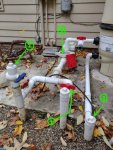I saw another thread on a similar topic, but since the setup is different, figured a new thread makes sense.
I have a mesh safety cover installation, and am preparing to do a DIY closing for the first time. (Well I had kind of done it once before, but since then my equipment has been upgraded to a different filter and plumbing).
Here is a picture of the setup:

The two suction lines are on the left (front), however only the one on the left is active for the main drain. My skimmer line has a leak in it and therefore I never used it for the whole summer. It has been closed since last fall and I never opened that line (even in the skimmer itself). I figure that doesn't need blowing anyway.
Pump and then cartridge filter (with a valve just before the filter entry that I use for draining water sometimes). The return line is the rightmost pipe.
What would be the best sequence of steps for blowing out this setup?
Thanks.
I have a mesh safety cover installation, and am preparing to do a DIY closing for the first time. (Well I had kind of done it once before, but since then my equipment has been upgraded to a different filter and plumbing).
Here is a picture of the setup:

The two suction lines are on the left (front), however only the one on the left is active for the main drain. My skimmer line has a leak in it and therefore I never used it for the whole summer. It has been closed since last fall and I never opened that line (even in the skimmer itself). I figure that doesn't need blowing anyway.
Pump and then cartridge filter (with a valve just before the filter entry that I use for draining water sometimes). The return line is the rightmost pipe.
What would be the best sequence of steps for blowing out this setup?
Thanks.



